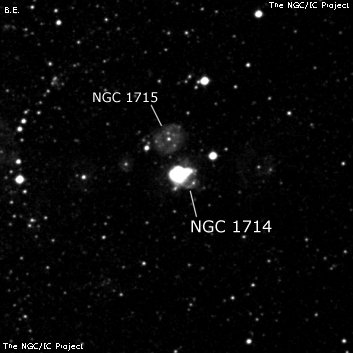
John Herschel discovered NGC 1714 = h2686 on 2 Nov 1834 and recorded "vB, S, E, bM, 15"; Has another very faint neb nearly north [h2687 = NGC 1715]." On later observations he described "vB, E or bi-nuclear, mbM, 40" long; the S.p. of two" and "vB, S, lE, psbM. Double or extended wedge-shaped."
Williamina Fleming reported NGC 1714 (N4A-1) as a gaseous nebula based on its photographic spectra, as part of the Draper survery. Probably as a result, NGC 1714 is plotted as an planetary on the Skalnate Pleso "Atlas of the Heavens" as well as the Sky Atlas 2000.0.
Joseph Turner sketched NGC 1714 and 1715 on 11 Nov 1876 with the Great Melbourne Telescope. NGC 1714 has a broad fan shape with the illuminated star on the east side (unpublished plate II, figure 18).
400/500mm - 18" (7/9/02 - Magellan Observatory, Australia): at 128x, I found a surprisingly bright, high surface brightness knot, ~30" diameter, with a brighter off-center core. A mag 11 star (M2-class supergiant) is 1' NW. Forms a close pair with fainter NGC 1715 just 1' NNE. NGC 1731 lies 8' E and NGC 1718 is 8' SSE. Situated in the NW corner of the LMC. This object also has an emission component but I didn't record if there was a filter response.
Notes by Steve Gottlieb